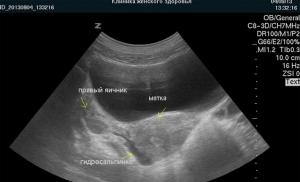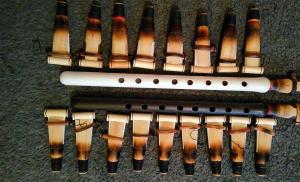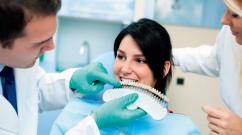Proteins of the complement system: properties and biological activity. Regulatory Mechanisms of Complement
Complement and its activation
Remark 1
Complement- This is a complex system of proteins, more than 30 in number, present in the cytoplasm and on the surface of cells.
Complement is a set of enzymes that are activated by various specific stimuli. In this case, a fast, multiply enhanced response is formed: the primary signal initiates a cascade process, in which the product of one reaction serves as an enzyme-catalyst for the next one.
Complement is important integral part innate immunity systems, since activated or cleavage products have a number of protective functions.
Many complement components are designated by the symbol "C" and a number that corresponds to the chronology of their discovery.
Brief description of some components of the complement system
Most of all in the body compared to other components of the complement contains component C3, which performs the most important functions.
Remark 2
AT normal conditions the $C3$ protein is constantly cleaved to form a functionally similar molecule. Subsequently, when interacting with other complement components, factor B and in the presence of magnesium ions, a new protein is formed that has a new important enzymatic activity - it is a $C3$-convertase.
The $C3$ split plays important role to eliminate pathogenic microbes.
- in the presence of a large number of microorganisms, $C3$-convertase activity appears;
- formed a large number of$C3$ cleavage products;
- binding to the surface of microbial cells;
- the bound convertase is affected by the properdin protein, which contributes to its greater stabilization;
- a large amount of $C3b$ protein accumulates on the surface of microbial cells.
Complement is activated when microbial surface carbohydrates bind to manno-binding lectin (MBL), which is a blood plasma protein.
- MSL binds to the residues of mannose and other carbohydrates that are part of bacterial cells;
- a series of reactions are initiated, culminating in complement activation;
- MSL activates complement by interacting with serine proteases;
- activation of $C3$ initiates the action of the positive feedback mechanism and the formation of the membrane-lysing complex.
The reactions initiated by $C3$ cleavage result in the formation of a membrane-lysing complex.
- as a result of a series of transformations, an amphipathic molecule is formed that can penetrate into the lipid bilayer and polymerize to form a membrane lysing complex (MLC);
- LMK forms a transmembrane channel, completely permeable to water and electrolytes;
- Due to the high intracellular pressure and the entry of sodium ions, water enters the cell, which leads to lysis.
During infection, $C3$ convertase stabilizes and complement is activated via an alternative pathway:
Biological functions of complement
Complement performs the following protective functions:
- The $C3b$ component binds complement receptors. Phagocytic cells carry receptors for complement components $C3b(CR1)$ and $C3bi(CR3)$, which promotes attachment of microbial cells to phagocytes and subsequent phagocytosis. The process of $C3bc$ binding by microbial cells is called opsonization.
When complement is activated, biologically active fragments are released. When $C3$ and $C5$ molecules are cleaved, small peptides $C3a$ and $C5a$ are formed, which are anaphylatoxins and perform a number of important functions:
- cause the release of protective mediators (histamine, tumor necrosis factor, leukotriene $B4$, etc.;
- affect eosinophils, $C5a$ - neutrophils;
- stimulate respiratory activity in cells;
- increase the expression of surface receptors for $C3b$;
- $5a$ - strong chemotactic agent for neutrophils;
- act on the capillary endothelium, dilating the vessels and increasing their permeability.
The membrane-lysing complement complex damages the membrane.
- Complement is involved in the induction of antibody formation. The receptor for $C3b$ is involved in the regulation of the activity of $B$-cells. The proliferation of $B$-cells and their synthesis of antibodies depend on the activation induced by antigen binding to surface cell receptors. In the presence of $C3b$, the threshold concentration of antigen for the activation of $B$-cells decreases, so they are activated at a much lower amount of antigen in the body.
organism. It is an important component of both innate and acquired immunity.
AT late XIX centuries, it was found that the blood serum contains a certain "factor" with bactericidal properties. In 1896, the young Belgian scientist Jules Bordet, who worked at the Pasteur Institute in Paris, showed that there are two different substances, the combined action of which leads to the lysis of bacteria: a thermostable factor and a thermolabile (losing its properties when the serum is heated) factor. The thermostable factor, as it turned out, could act only against certain microorganisms, while the thermolabile factor had nonspecific antibacterial activity. The thermolabile factor was later named complement. The term "complement" was coined by Paul Ehrlich in the late 1890s. Ehrlich was the author of the humoral theory of immunity and introduced many terms into immunology, which later became generally accepted. According to his theory, cells responsible for immune responses have receptors on their surface that serve to recognize antigens. We now call these receptors "antibodies" (the basis of the variable receptor of lymphocytes is an IgD class antibody attached to the membrane, less often IgM. Antibodies of other classes in the absence of the corresponding antigen are not attached to cells). The receptors bind to a specific antigen, as well as to the heat-labile antibacterial component of the blood serum. Ehrlich called the thermolabile factor "complement" because this blood component "serves as a complement" to cells immune system.
Ehrlich believed that there are many complements, each of which binds to its own receptor, just as a receptor binds to a specific antigen. In contrast, Bordet argued that there is only one type of "complement". At the beginning of the 20th century, the dispute was resolved in favor of Bordet; it turned out that complement can be activated with the participation of specific antibodies or independently, in a non-specific way.
Complement is a protein system that includes about 20 interacting components: C1 (a complex of three proteins), C2, C3, ..., C9, factor B, factor D and a number of regulatory proteins. All these components are soluble proteins with a mol. weighing from 24,000 to 400,000, circulating in the blood and tissue fluid. Complement proteins are synthesized mainly in the liver and make up approximately 5% of the total globulin fraction of blood plasma. Most are inactive until activated either by an immune response (involving antibodies) or directly by an invading microorganism (see below). One of possible outcomes complement activation - the sequential combination of the so-called late components (C5, C6, C7, C8 and C9) into a large protein complex that causes cell lysis (lytic, or membrane attack complex). Aggregation of late components occurs as a result of a series of successive proteolytic activation reactions involving early components (C1, C2, C3, C4, factor B and factor D). Most of these early components are proenzymes that are sequentially activated by proteolysis. When any of these proenzymes is specifically cleaved, it becomes the active proteolytic enzyme and cleaves the next proenzyme, and so on. Because many of the activated components bind tightly to membranes, most of these events occur on cell surfaces. The central component of this proteolytic cascade is C3. Its activation by cleavage is the main reaction of the entire complement activation chain. C3 can be activated in two main ways - classical and alternative. In both cases, C3 is cleaved by an enzyme complex called C3 convertase. Two different pathways lead to the formation of different C3 convertases, but both of them are formed as a result of the spontaneous combination of two complement components activated earlier in the chain of the proteolytic cascade. C3 convertase cleaves C3 into two fragments, the larger of which (C3b) binds to the target cell membrane next to C3 convertase; resulting in the formation of an enzyme complex large sizes with modified specificity - C5-convertase. Then the C5 convertase cleaves C5 and thereby initiates the spontaneous assembly of the lytic complex from the late components - from C5 to C9. Since each activated enzyme cleaves many molecules of the next proenzyme, the activation cascade of early components acts as an amplifier: each molecule activated at the beginning of the entire chain leads to the formation of many lytic complexes.
The complement system works as a biochemical cascade of reactions. Complement is activated by three biochemical pathways: the classical, alternative, and lectin pathways. All three activation pathways produce different variants C3 convertase (protein that cleaves C3). classic way(it was discovered first, but evolutionarily new) requires antibodies to activate (specific immune response, adaptive immunity), while alternative and lectin pathways can be activated by antigens without the presence of antibodies (nonspecific immune response, innate immunity). The result of complement activation in all three cases the same: C3 convertase hydrolyzes C3, creating C3a and C3b and causing a cascade of further hydrolysis of complement system elements and activation events. In the classical pathway, activation of C3 convertase requires the formation of the C4bC2a complex. This complex is formed upon cleavage of C2 and C4 by the C1 complex. The C1 complex, in turn, must bind to class M or G immunoglobulins for activation. C3b binds to the surface of pathogens, which leads to a greater “interest” of phagocytes in C3b-associated cells (opsonization). C5a is an important chemoattractant that helps attract new immune cells to the area of complement activation. Both C3a and C5a have anaphylotoxic activity, directly causing degranulation of mast cells (as a result, release of inflammatory mediators). C5b starts the formation of membrane attack complexes (MACs) consisting of C5b, C6, C7, C8 and polymeric C9. MAC - cytolytic final product activation of the complement system. MAC forms a transmembrane channel that causes osmotic lysis of the target cell. Macrophages engulf pathogens labeled by the complement system.
Factor C3e, formed by the breakdown of factor C3b, has the ability to cause the migration of neutrophils from the bone marrow, and in this case, be the cause of leukocytosis.
The classical path is triggered by the activation of the complex C1(it includes one C1q molecule and two C1r and C1s molecules each). The C1 complex binds via C1q to class M and G immunoglobulins associated with antigens. Hexameric C1q is shaped like a bouquet of unopened tulips, the “buds” of which can bind to the α-site of antibodies. A single IgM molecule is sufficient to initiate this pathway, activation by IgG molecules is less efficient and requires more IgG molecules.
С1q binds directly to the surface of the pathogen, this leads to conformational changes in the C1q molecule, and causes the activation of two molecules of C1r serine proteases. They cleave C1s (also a serine protease). The C1 complex then binds to C4 and C2 and then cleaves them to form C2a and C4b. C4b and C2a bind to each other on the surface of the pathogen to form the classical pathway C3 convertase, C4b2a. The appearance of C3 convertase leads to the splitting of C3 into C3a and C3b. C3b forms, together with C2a and C4b, the C5 convertase of the classical pathway. C5 is cleaved into C5a and C5b. C5b remains on the membrane and binds to the C4b2a3b complex. Then C6, C7, C8 and C9 are connected, which polymerizes and a tube appears inside the membrane. Thus, the osmotic balance is disturbed and, as a result of turgor, the bacterium bursts. The classical way is more accurate, since any foreign cell is destroyed in this way.
An alternative pathway is triggered by hydrolysis of C3 directly on the surface of the pathogen. Factors B and D are involved in the alternative pathway. With their help, the formation of the C3bBb enzyme occurs. Protein P stabilizes it and ensures its long-term functioning. Further, PC3bBb activates C3, as a result, C5-convertase is formed and the formation of a membrane attack complex is triggered. Further activation of the terminal complement components occurs in the same way as in the classical pathway of complement activation. In the liquid in the C3bBb complex, B is replaced by the H-factor and, under the influence of a deactivating compound (H), is converted to C3bi. When microbes enter the body, the C3bBb complex begins to accumulate on the membrane, catalyzing the splitting of C3 into C3b and C3a, significantly increasing the concentration of C3b. Another C3b molecule joins the properdin+C3bBb complex. The resulting complex cleaves C5 into C5a and C5b. C5b remains on the membrane. There is a further assembly of MAC with alternate addition of factors C6, C7, C8 and C9. After the connection of C9 with C8, C9 polymerization occurs (up to 18 molecules are crosslinked with each other) and a tube is formed that penetrates the bacterial membrane, water is pumped in and the bacterium bursts.
The alternative path differs from the classical one in the following way: when the complement system is activated, no education is needed immune complexes, it occurs without the participation of the first complement components - C1, C2, C4. It also differs in that it works immediately after the appearance of antigens - its activators can be bacterial polysaccharides and lipopolysaccharides (they are mitogens), viral particles, tumor cells.
The lectin pathway is homologous to the classical pathway of activation of the complement system. It uses the mannose-binding lectin (MBL), a protein similar to the classical C1q activation pathway, that binds to mannose residues and other sugars on the membrane to allow recognition of a variety of pathogens. MBL is a serum protein belonging to the group of collectin proteins, which is synthesized mainly in the liver and can activate the complement cascade by directly binding to the surface of the pathogen.
In blood serum, MBL forms a complex with MASP-I and MASP-II (Mannan-binding lectin Associated Serine Protease, MBL-binding serine proteases). MASP-I and MASP-II are very similar to C1r and C1s of the classical activation pathway and may have a common evolutionary ancestor. When several MBL active sites bind in a specific manner to oriented mannose residues on the pathogen's phospholipid bilayer, MASP-I and MASP-II are activated and cleave the C4 protein into C4a and C4b, and the C2 protein into C2a and C2b. C4b and C2a then combine on the surface of the pathogen to form C3 convertase, and C4a and C2b act as chemoattractants for cells of the immune system.
The complement system can be very dangerous to host tissues, so its activation must be well regulated. Most of the components are active only as part of the complex, while their active forms able to exist for a very short time. If during this time they do not meet with the next component of the complex, then the active forms lose their connection with the complex and become inactive. If the concentration of any of the components is below the threshold (critical), then the work of the complement system will not lead to physiological consequences. The complement system is regulated by special proteins that are found in blood plasma in even higher concentrations than the complement system proteins themselves. The same proteins are present on the membranes of the body's own cells, protecting them from attack by the proteins of the complement system.
The complement system plays a large role in many immune-related diseases.
In immune complex disease, complement provokes inflammation mainly in two ways:
Already in the first hours after infection with Ebola hemorrhagic fever, the complement system is blocked
Without regulatory mechanisms acting at many stages, the complement system would be ineffective; unlimited consumption of its components could lead to severe, potentially fatal damage to the cells and tissues of the body. At the first stage, the C1 inhibitor blocks the enzymatic activity of Clr and Cls and, consequently, the cleavage of C4 and C2. Activated C2 lasts only a short time, and its relative instability limits the lifetime of C42 and C423. The alternative pathway activating C3 enzyme, C3bBb, also has short time half-life, although the binding of properdin to the enzyme complex prolongs the lifetime of the complex.
AT serum there is an inactivator of anaphylatoxins - an enzyme that cleaves off the N-terminal arginine from C4a, C3a and C5a and thereby sharply reduces their biological activity. Factor I inactivates C4b and C3b, factor H accelerates the inactivation of C3b by factor I, and a similar factor, C4-binding protein (C4-bp), accelerates the cleavage of C4b by factor I. Three constitutional cell membrane proteins - PK1, membrane cofactor protein and a factor that accelerates decay (FUR) - destroy C3- and C5-convertase complexes that form on these membranes.
Other components of cell membranes- associated proteins (among which CD59 is the most studied) - can bind C8 or C8 and C9, which prevents the incorporation of the membrane attack complex (C5b6789). Some blood serum proteins (among which protein S and clusterin are the most studied) block the attachment of the C5b67 complex to the cell membrane, its binding of C8 or C9 (i.e., the formation of a full-fledged membrane attack complex) or otherwise prevent the formation and incorporation of this complex.
The protective role of complement
Neutralization viruses C1 and C4 are enhanced by antibodies and increase even more when C3b is fixed, which is formed along the classical or alternative pathway. Thus, complement is of particular importance in early stages viral infection when the amount of antibodies is still small. Antibodies and complement limit the infectivity of at least some viruses by forming the typical complement "holes" visible on electron microscopy. The interaction of Clq with its receptor opsonizes the target, i.e. facilitates its phagocytosis.
C4a, C3a and C5a are fixed by mast cells, which begin to secrete histamine and other mediators, leading to vasodilation and edema and hyperemia characteristic of inflammation. Under the influence of C5a, monocytes secrete TNF and IL-1, which enhance the inflammatory response. C5a is the main chemotactic factor for neutrophils, monocytes and eosinophils capable of phagocytizing microorganisms opsonized by C3b or its cleavage product iC3b. Further inactivation of cell-bound C3b, leading to the appearance of C3d, deprives it of its opsonizing activity, but its ability to bind to B-lymphocytes is retained. C3b fixation on the target cell facilitates its lysis by NK cells or macrophages.
C3b binding with insoluble immune complexes solubilizes them, since C3b, apparently, destroys the lattice structure of the antigen-antibody complex. At the same time, it becomes possible for this complex to interact with the C3b receptor (PK1) on erythrocytes, which transfer the complex to the liver or spleen, where it is absorbed by macrophages. This phenomenon partly explains the development of serum sickness (immune complex disease) in individuals with C1, C4, C2, or C3 deficiency.
Complement - it is an enzyme system that includes about 20 proteins that play an essential role in nonspecific defense, inflammation, and destruction (lysis) of bacterial membranes and various foreign cells. The complement system consists of 9 components, denoted by the Latin letter C (C1, C2, C3, etc.), and the first of them consists of 3 subcomponents - C1q, C1r and C1s. The complement system also includes regulatory proteins (B, D, P) and special inhibitor components that regulate the activation of this system and circulate in the blood. The latter include C1-esterase inhibitor (C1-In), C3b-inactivator, or factor I, and factor H, which cause dissociation of C3b into inactive subunits. Most of the complement components are synthesized by hepatocytes and mononuclear phagocytes (macrophages and monocytes). All complement components circulate in the blood in an inactive state.
In the process of activation of the complement system, its individual components are broken down into large (b) and small (a) fragments that directly affect the course of specific and nonspecific defensive reactions. The only exceptions to this rule are fragments C2a and C2b, which have changed their places (C2a - large, C2b - small fragment).
According to the figurative expression of the American immunologist Hugh Barber, the antigen-antibody reaction is just a declaration of war, the activation of the complement system is the mobilization of soldiers for battle. They begin to shoot when active complement fragments and a membrane attack complex (MAC) appear.
Exist classical and alternative ways of system activation complement. Let us dwell briefly on the characteristics of the individual components of the complement system as they are activated along both pathways.
Classic activation path.
C1-component is a Ca 2+ -dependent connection of 3 subcomponents. The C1q molecule has 6 valences for binding to immunoglobulins, after which the C1r and C1s proenzymes enter the active state, due to which the C2 and C4 components are activated.
C2 cleaved by the active subcomponent C1s into 2 fragments - small (C2b) and large (C2a).
C4 splits into small (C4a) and large (C4b) fragments, after which both fragments are attached to the Ag + Ab complex, or to the cell membrane, if Ag is associated with it. As a result of these reactions, C3-convertase (C4bC2a) is formed.
C3 is a component due to which the main functions of the complement system are carried out. It is cleaved by C3 convertase into small (C3a) and large (C3b) fragments. Partially, C3b settles on the membrane and connects with phagocytes through it. The other part of C3b remains bound to C2a and C4b, resulting in the formation of C5-convertase (C4bC2aC3b). There are inactivators that break down C3b into small fragments of C3c (free) and C3e (membrane-bound).
C5 cleaved by C5-convertase into small (C5a) and large (C5b) fragments. Fragments C3a and C5a act on mast cells and cause their degranulation. In addition, they stimulate the function of granulocytes and smooth muscles, promoting the development inflammatory processes. The C5b fragment initiates the assembly of the membrane attack complex (MAC).
Alternative way of activation.
Factor B - a protein with MM 100,000 Da, which forms a complex with C3b, regardless of which pathway it is a product of.
FactorD is an enzyme with an MM of about 25,000 Da, acting on the C3bB complex, resulting in the formation of a convertase (C3bBb).
P factor- a protein that stabilizes the C3bB complex, which cleaves C3 into fragments C3a and C3b. The resulting C3b interacts with factors B and D, resulting in a sharp increase in the concentration of C3b by the feedback mechanism. This reaction is limited by factors I and H, which inactivate C3.
Components C5, C6, C7, C8, C9 are common to the classical and alternative pathways of activation of the complement system. At the same time, the component C9 in structure and properties it resembles CTL perforin and NK-lymphocytes.
The main initiators of the classical path activation of the complement system are immune complexes (Ag + Ab), staphylococci (protein A), complexes of C-reactive protein with ligands, some viruses and virus-affected cells, cytoskeletal elements of cells, and others. The classical path begins with the activation of the C1 component, which cascades its subcomponents (C1q, C1r, C1s), C4, C2, C3 and subsequent ones up to C9.
POPPY is a hollow protein cylinder (height 160 Å, while the inner diameter varies depending on the number of built-in C9 molecules), which is immersed due to the hydrophobic components of C9 into the phospholipid part of the membrane of foreign cells. Therefore, MAC performs the functions of perforin. Thanks to the holes formed in the membrane, the contents of the cell flow out, and it dies. The death of own cells is prevented due to the presence of species-specific inhibitors of complementary activation (C3b, C4b) and C8-binding protein in the membrane.
receptors for complement found on erythrocytes, phagocytes, endotheliocytes, mast cells and B-lymphocytes. All of them bind the cleavage products of the C3 component of complement.
The complement system performs the following functions:
Opsonic, i.e. stimulates phagocytosis. These effects are carried out under the influence of C3b, C1q, Bb, C4b, C5b, C5b6, C5b67;
Chemotactic- due to C5a, C3e, C3a, etc.;
mast cell activation, resulting in the release of histamine, which dilates the capillaries and causes local redness during inflammation and allergic reactions; this function is associated with fragments C5a, C3a, Ba, C4a;
Lysis of bacteria, foreign as well as old cells, from the surface of which protective proteins are “sloughed off”;
Dissolution immune complexes, carried out by fragments C3b and C4b.
Participation of the complement system in the purification of the vascular bed from single bacterial cells that have entered the bloodstream is associated with activation along an alternative pathway. As a result of the immune response, antibodies to these bacteria accumulate in the blood serum. The interaction of these Abs with Ag on the surface of bacteria creates conditions for the activation of the complement system along the classical pathway, resulting in bacteriolysis (Fig. 9).
In people with a deficiency of C1-C4 complement components, frequent recurrences of inflammatory diseases and pyogenic infection are observed. Deficiency of factor P, which stabilizes the multimolecular enzymatic complex C5-convertase of the alternative pathway, is accompanied by an increase in sensitivity to gonococci and meningococci.
Decreased activity of the complement system ( hypocomplementemia) may be caused by a decrease in the production of complement components, or by their increased consumption. The latter may be due to the appearance of immune complexes that bind complement and, together with it, are captured by phagocytic cells. Thus, the vascular bed is cleared of excess CI. Hypocomplementemia is a fairly common occurrence in autoimmune processes and other diseases, which adversely affects the patient's condition.
We will focus on other types of nonspecific resistance when we get acquainted with immunity.
Complement is a complex protein complex in the blood serum. Complement system consists of 30 proteins (components, or factions, complement systems). Activated complement system due to the cascade process: the product of the previous reaction acts as a catalyst for the subsequent reaction. Moreover, when the fraction of the component is activated, in the first five components, its splitting occurs. The products of this splitting are denoted as active fractions of the complement system.
1. Larger of fragments(denoted by the letter b), formed during the cleavage of the inactive fraction, remains on the cell surface - complement activation always occurs on the surface of the microbial cell, but not on its own eukaryotic cells. This fragment acquires the properties of an enzyme and the ability to act on the subsequent component, activating it.
2. Smaller Fragment(denoted by the letter a) is soluble and "leaves" in the liquid phase, i.e. into the blood serum.
B. Fractions of the complement system are designated differently.
1. Nine - opened first- proteins of the complement system marked with the letter C(from English word complement) with the corresponding digit.
2. The remaining fractions of the complement system are designated other Latin letters or their combinations.
Complement activation pathways
There are three complement activation pathways: classical, lectin, and alternative.
BUT. classic way complement activation is main. Involved in this complement activation pathway main function of antibodies.
1. Complement activation via the classical pathway starts up immune complex : antigen-immunoglobulin complex (class G or M). The place of the antibody can "take" C-reactive protein- such a complex also activates complement along the classical pathway.
2. Classic pathway of complement activationcarried out in the following way.
a. First fraction C1 is activated: it is collected from three subfractions (C1q, C1r, C1s) and converted into an enzyme C1-esterase(С1qrs).
b. C1-esterase splits the C4 fraction.
in. The active fraction C4b covalently binds to the surface of microbial cells - here joins the C2 faction.
d. Fraction C2 in complex with fraction C4b is cleaved by C1-esterase with formation of the active fraction С2b.
e. Active fractions C4b and C2b in one complex - С4bС2b- Possessing enzymatic activity. This so-called Classical pathway C3 convertase.
e. C3 convertase splits the C3 fraction, I'm earning large quantities active fraction C3b.
and. Active fraction С3b joins the C4bC2b complex and turns it into C5 convertase(С4bС2bС3b).
h. C5 convertase splits the C5 fraction.
and. The resulting active fraction C5b joins the C6 faction.
j. C5bC6 complex joins the C7 faction.
l. Complex С5bС6С7 embedded in the phospholipid bilayer of the microbial cell membrane.
m. To this complex protein C8 joins and protein C9. This polymer forms a pore with a diameter of about 10 nm in the membrane of a microbial cell, which leads to the lysis of the microbe (since many such pores are formed on its surface - the “activity” of one unit of C3-convertase leads to the appearance of about 1000 pores). Complex С5bС6С7С8С9, formed as a result of complement activation is called memran attack complex (POPPY).
B. lectin pathway Complement activation is triggered by a complex of a normal blood serum protein - mannans-binding lectin (MBL) - with carbohydrates of the surface structures of microbial cells (with mannose residues).
AT  .Alternative path Complement activation begins with the covalent binding of the active C3b fraction - which is always present in the blood serum as a result of the spontaneous cleavage of the C3 fraction that constantly occurs here - with the surface molecules of not all, but some microorganisms.
.Alternative path Complement activation begins with the covalent binding of the active C3b fraction - which is always present in the blood serum as a result of the spontaneous cleavage of the C3 fraction that constantly occurs here - with the surface molecules of not all, but some microorganisms.
1. Further developmentsdevelop in the following way.
a. C3b binds factor B, forming a C3bB complex.
b. Associated with C3b factor B acts as a substrate for factor D(serum serine protease), which cleaves it to form the active complex С3bВb. This complex has enzymatic activity, is structurally and functionally homologous to the C3-convertase of the classical pathway (C4bC2b) and is called C3-convertase alternative pathway.
in. Alternate pathway C3 convertase itself is unstable. For the alternative pathway of complement activation to continue successfully this enzyme stabilized by factor P(properdin).
2. Mainfunctional difference An alternative way of complement activation, in comparison with the classical one, is the rapid response to the pathogen: since it does not take time for the accumulation of specific antibodies and the formation of immune complexes.
D. It is important to understand that both the classical and alternative pathways of complement activation operate in parallel, also amplifying (i.e. amplifying) each other. In other words, the complement is activated not "either by the classical or by the alternative", but "by both the classical and the alternative" pathways of activation. This, with the addition of the lectin activation pathway, is a single process, the different components of which can simply manifest themselves to different degrees.
Functions of the complement system
The complement system plays a very important role in host defense against pathogens.
A. The complement system is involved in inactivation of microorganisms, incl. mediates the action of antibodies on microbes.
B. Active fractions of the complement system activate phagocytosis (opsonins - C3b andC5 b) .
B. Active fractions of the complement system are involved in formation of an inflammatory response.
The active complement fractions C3a and C5a are called anaphylotoxins, as they are involved, among other things, in an allergic reaction called anaphylaxis. The strongest anaphylotoxin is C5a. Anaphyllotoxins operate on different cells and tissues of the macroorganism.
1. Their effect on mast cells causes degranulation.
2. Anaphylotoxins also act on smooth muscles causing them to contract.
3. They also work on vessel wall: cause activation of the endothelium and increase its permeability, which creates conditions for extravasation (output) of fluid and blood cells from the vascular bed during the development of an inflammatory reaction.
In addition, anaphylotoxins are immunomodulators, i.e. they act as regulators of the immune response.
1. C3a acts as an immunosuppressor (i.e. suppresses the immune response).
2. C5a is an immunostimulant (i.e. enhances the immune response).
QUESTION 10 “Immunity is a concept. Classification of forms of immunity. organs of the immune system. Immunogenesis»
Immunity is understood defense mechanisms, which are realized with the participation of lymphocytes and are aimed at recognition and elimination from internal environment an organism of a group of molecules or even parts of molecules, considered as a "foreign label". The term antigen. Recognizing these "marks" - antigens, the immune system removes from the internal environment of the body:
own, which have become different reasons unnecessary, cells,
microorganisms,
food, inhalation and application external substances,
transplants.
There are two main forms of immunity- specific (congenital) and acquired. There is a classification acquired immunity depending on its origin, according to which it is divided into natural (not to be confused with natural immunity due to nonspecific resistance factors) and artificial.
BUT. Natural acquired immunity is formed naturally (hence the name).
1. Active natural acquired immunity is formed as a result of an infection and is therefore called post-infectious.
2. Passive natural acquired immunity is formed due to maternal antibodies that enter the body of the fetus through the placenta, and after birth - into the body of the child with mother's milk. As a result, this type of immunity is called maternal.
B. Artificial acquired immunity is formed in the patient by a doctor.
1. Active artificial acquired immunity is formed as a result of vaccination and is therefore called post-vaccination.
2. Passive artificial acquired immunity is formed as a result of the introduction of therapeutic and prophylactic sera and is therefore called postserum.
Acquired immunity can bealso sterile (without the presence of a pathogen)and non-sterile (existing in the presence of a pathogen in the body),humoral andcellular, systemic andlocal, by direction -antibacterial, antiviral, antitoxic, antitumor, antitransplantation.
The immune system - a set of organs, tissues and cells that ensure the cellular-genetic constancy of the body. Principles antigenic (genetic) purity are based on the recognition of "one's own - someone else's" and are largely due to the system of genes and glycoproteins (products of their expression) - major histocompatibility complex (MHC), in humans, often referred to as the HLA (human leukocyte antigens) system.
organs of the immune system.
Allocate central(bone marrow - hematopoietic organ, thymus or thymus, intestinal lymphoid tissue) and peripheral(spleen, lymph nodes, accumulations of lymphoid tissue in its own layer of mucous membranes of the intestinal type) immune organs.
The immune system includes:
LYMPHOID SYSTEM (lymphoid organs and lymphocytes)
MONOCYTE-MACROPHAGE SYSTEM ( monocytes, tissue macrophages , dendritic cells , microphages orpolymornonuclear granulocytes are basophils, eosinophils, neutrophils).
The immune system includes levels:
Organ level
Cellular level (macrophages and microphages, T and B lymphocytes, monocytes, platelets and other cells)
Humoral or molecular level(immunoglobulins or antibodies, cytokines, interferons, etc.).
CYTOKINES- biologically active molecules that ensure the interaction of cells of the immune system with each other and with other systems
ORGANS OF THE IMMUNE SYSTEM
A. CENTRAL AUTHORITIES:
thymus
Bone marrow
FUNCTION: Formation, antigen-independent differentiation and proliferation of immunocompetent cells.
B. PERIPHERAL ORGANS:
The lymph nodes
Spleen
Lymphoid tissue of the mucous membranes (Peyer's patches of the intestine, appendix, tonsils, diffuse accumulations of lymphocytes in the lungs and intestines, etc.).
FUNCTION: Antigen-dependent differentiation and proliferation of immunocompetent cells.
Progenitor cells of immunocompetent cells are produced by the bone marrow. Some descendants of stem cells become lymphocytes. Lymphocytes are divided into two classes - T and B. The precursors of T-lymphocytes migrate to the thymus, where they mature into cells that can participate in the immune response. In humans, B-lymphocytes mature in the bone marrow. In birds, immature B cells migrate to the bursa of Fabricius where they reach maturity. Mature B and T lymphocytes colonize the peripheral lymph nodes. In this way, the central organs of the immune system carry out the formation and maturation of immunocompetent cells, peripheral organs provide an adequate immune response to antigenic stimulation - "processing" of the antigen, its recognition and clonal proliferation of lymphocytes -antigen-dependent differentiation.













